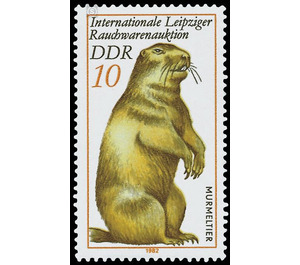International Leipzig Smoked Goods Auction - Germany / German Democratic Republic 1982 - 10 Pfennig
Theme: Animals
| Country | Germany / German Democratic Republic |
| Issue Date | 1982 |
| Face Value | 10.00 |
| Color | brown |
| Perforation | K 14 |
| Printing Type | Rotogravure 2 |
| Stamp Type | Postage stamp |
| Item Type | Stamp |
| Chronological Issue Number | 2419 |
| Chronological Chapter | GER-DDR |
| SID | 287226 |
| In 26 Wishlists | |
For the International Leipzig Smoke Auction Auction At the International Leipzig Smoke Goods Auction, the Ministry of Posts and Telecommunications of the German Democratic Republic issues four multicolored special postage stamps. Special cancellation from February 23 to April 22, 1982 The International Leipzig Smoke Auction Auctions Four international smoking product auctions are held each year in Leipzig, a traditional fur trade and fur processing center. They take place in February, April, June and October of each year. In addition to skins from the GDR, such as mink, rabbit and marten, skins from various European and Asian countries are also on offer here. At the same time, the socialist countries make up the majority of foreign consignments. Thus, the USSR participates with large quantities of Karakul and mink skins at the auctions. The People's Republic of Poland sells large numbers of blue and silver foxes, mutation and standard nutria, polecats, martens and rabbits via the Leipzig auctions. The Mongolian People's Republic delivers wild goods to Leipzig. Among them are large quantities of marmots, silver foxes and mink as well as dog fur, wolves, wild cats and other wild fur species. In addition to these largest goods owners, the Democratic People's Republic of Korea, Czechoslovakia, the People's Republic of Bulgaria, the SVR Albania, the Hungarian People's Republic and the DR Afghanistan participate in the International Leipzig Smoke Auction Auction. The buyers of these offered skins come from the capitalist countries of Europe, as well as from the USA, from Canada and Japan. The USA and Canada are the main buyers for mink skins and also for blue and silver foxes. Smoking product auctions are also carried out in Europe in London, Leningrad, Oslo, Helsinki and Copenhagen. The process is basically the same everywhere. The supplied skins are sorted according to quality and size and bundled in industry standard quantities. These bundles are called lots, which are listed in auction catalogs. The customer receives the auction catalogs from the auction company and inspects the goods before the auction begins. When selling a limit price is set for each lot, which must reach the seller (auctioneer) when offering the lot. If customers are interested in the lot, they will outperform the previously offered price. The highest bid is confirmed by a hammer blow of the auctioneer as a retail price and the lot is thus sold. This special postage stamp series shows some animals whose skins are used in the tobacco industry for fur products. The 10-pfennig value shows a marmot. These skins come from the Mongolian People's Republic. Marmots are pure herbivores that grow to about 40 cm tall and have a rust yellowish color. Marmots are usually dyed into coats and jackets, furthermore as collars, trimmings or caps.


